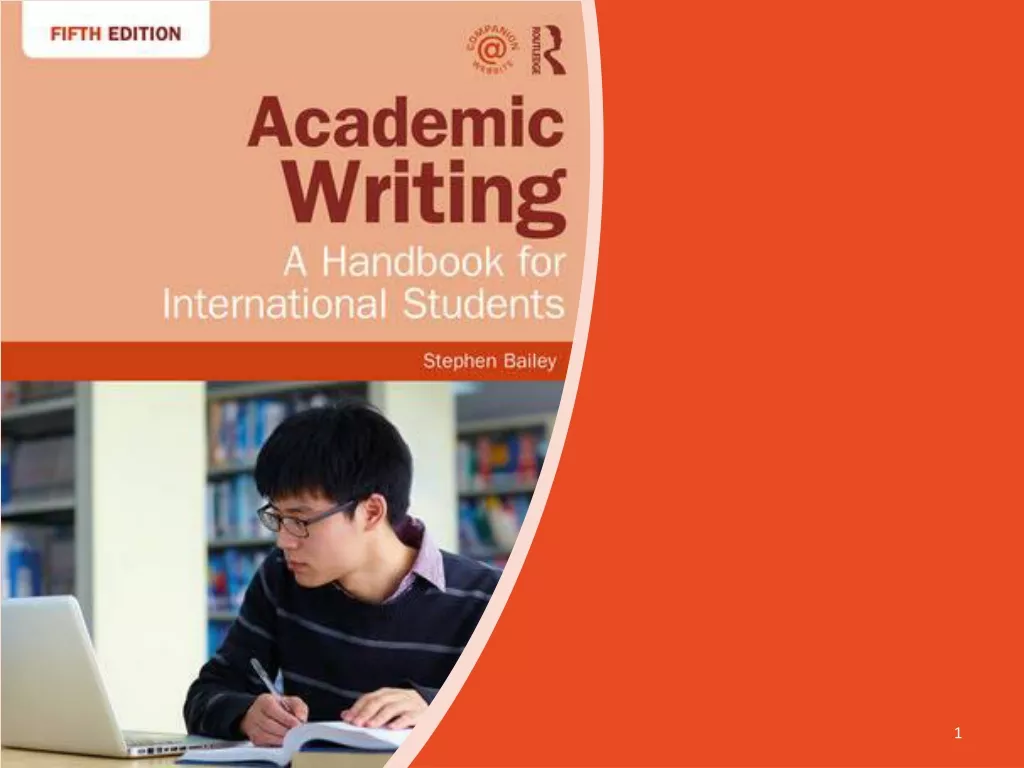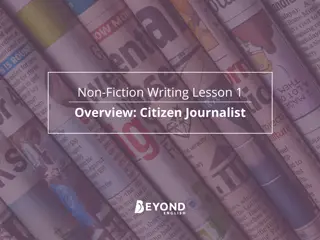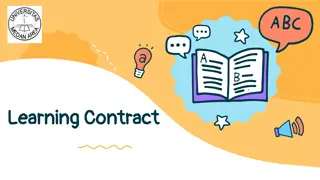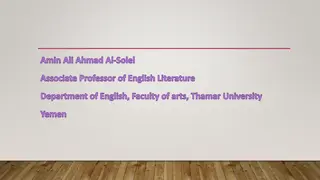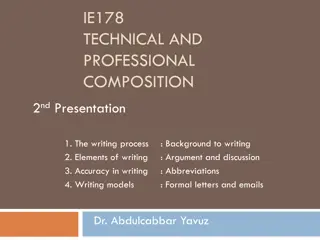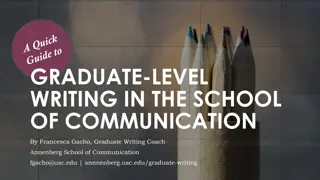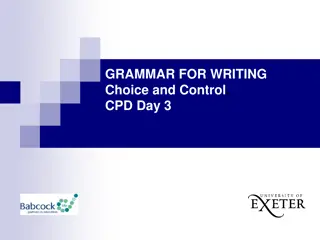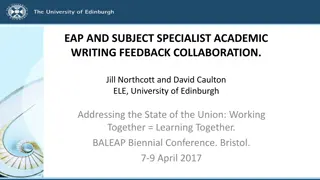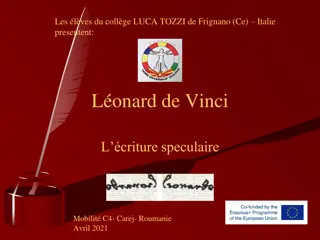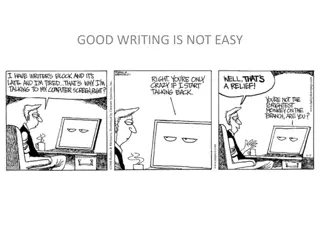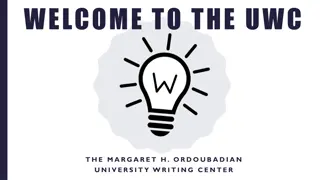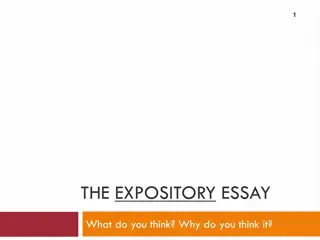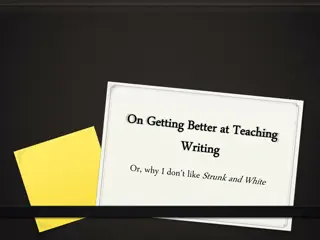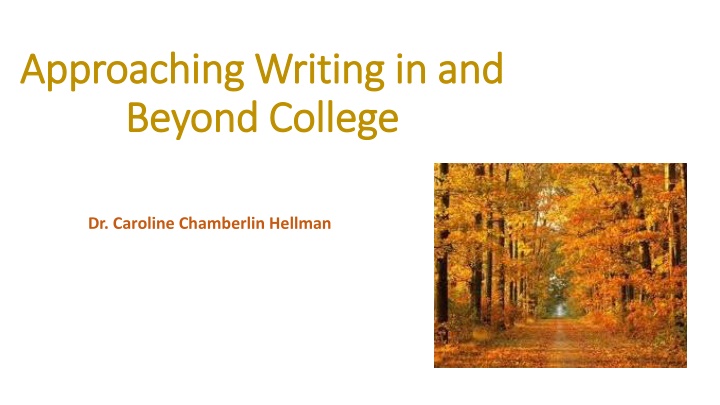
Effective Strategies for Writing Beyond College Level
Discover useful tips and steps for approaching writing tasks with confidence, including pre-writing techniques, writing processes, and proofreading methods. Learn about major categories to consider in writing, essay structure, and essential elements like introduction strategies. Empower yourself to tackle various writing projects and improve your writing skills effectively.
Uploaded on | 2 Views
Download Presentation

Please find below an Image/Link to download the presentation.
The content on the website is provided AS IS for your information and personal use only. It may not be sold, licensed, or shared on other websites without obtaining consent from the author. If you encounter any issues during the download, it is possible that the publisher has removed the file from their server.
You are allowed to download the files provided on this website for personal or commercial use, subject to the condition that they are used lawfully. All files are the property of their respective owners.
The content on the website is provided AS IS for your information and personal use only. It may not be sold, licensed, or shared on other websites without obtaining consent from the author.
E N D
Presentation Transcript
Approaching Writing in and Approaching Writing in and Beyond College Beyond College Dr. Caroline Chamberlin Hellman
3AM. We face off against the white screen of a blank Microsoft Word document. The terror is overwhelming! We run screaming from the room!
Or, we can walk determinedly back to the computer. We refuse to be intimidated! Yes, writing can be frightful, but if we break down projects into increments and small tasks if we *scaffold* and build gradually eventually we will have a pleasant house before us. How do we start building? Come along and find out!
Writing, like building, is a process. No matter what we are writing (a job cover letter? An essay? A podcast? An editorial? A presentation for class?), there are 3 useful steps: 1. Pre-writing (brainstorming, sketching structure, outlining) 2. Writing 3. Proofreading (checking clarity of ideas, organization, development, grammar, formatting)
Major Categories to Consider Definition Argumentation Expressing your ideas and supporting them with evidence Organization Sensible structure and how ideas are presented; paragraph sequence contributes to a progression of ideas, avoiding repetition Development Supporting and expanding upon ideas with specific examples and details Grammar, Sentence Structure, & Word Choice Clarity of sentences; appropriate word choice; subject- verb agreement; tense consistency; avoiding run-on sentences and sentence fragments; variety of sentence structure; appropriate punctuation (period, comma, semi-colon, etc)
Essay Structure Introduction Begins with a HOOK (to grab reader s attention) Possible hooks: brief anecdote (personal story or current events story), quote from relevant source (source citation info needed), ample detail about setting of story to come (set the scene for your reader) After hook, transition to introducing topic and providing background info to orient your reader, lay groundwork for discussion to follow Can end with thesis statement or main point of essay (if writing persuasive essay; sometimes narrative essays end with a thesis, too) No set length; typical minimum 4-5 sentences
Essay Structure Body Paragraphs Conventional academic essays have 3 or more paragraphs but there is a whole world beyond this; do not feel constrained Paragraph chronology (sequence) should help you progress through your ideas Paragraphs= minimum 4-5 sentences Content Breakdown Topic sentence: first sentence of paragraph that indicates your main idea and provides an overview Supporting sentences: develop and explain your idea; supporting details elaborate on what you mean and include examples and evidence in form of personal story, sometimes connections to outside material (texts, TV, film, current events/ newspaper articles, statistics, etc) Wrap-up/ concluding sentence: draws conclusions from info just presented, supports thesis
Essay Structure Conclusion Reflects back on subject matter and wraps up ideas of essay Potential implications of your work No set length; can be shorter than intro and BPs (3 or more sent)
Name Class Professor Assignment Date Center, Bold Title Aim for creative! Drop down essay text; use Tab to indent each paragraph; double space (under Paragraph) 12 font; no extra space between BPs
The Quote Sandwich: Your New Friend 1. Bread: Set up and introduce quote. Include the author, text title (capitalized), and publication year. Summarize the text fully (this will take several sentences!) Example:In Maybe I Could Save Myself by Writing (2017), Jose Olivarez writes about the challenge of navigating different aspects of his identity in school settings. (continued in other summary sentences) 2. Veggies/ meat/ tofu: The quote itself, with a page citation if possible (if no page, cite paragraph #), or line number citation if a poem Ex:Olivarez writes, I m telling you this because I wrote a book of poems with one foot in the past, one hand in the present, and a nose on the future (45). 3. Bread: Analyze quote. Avoid repeating the quote or merely paraphrasing. Instead, say what the quote means, and then explain how it relates to your own writing. Ex: Here Olivarez emphasizes the importance of his family history in his writing, as well as who he is as an individual. His point relates to
Rough Draft Checklist 1. Is my essay the right length? Is it properly formatted? (go back to assignment guidelines) 2. Does my writing fulfill the assignment expectations (re-read assignment guidelines to verify) 3. Does the introduction set the scene for the reader and fully introduce the topic and focus? 4. Is the thesis, or main idea I wish to propose, clear? Is there a way to clarify it further? 5. Does the BP order (sequence) make sense? 6. Do BP examples adequately support main ideas? Could some examples be more fully developed? 7. Are text connections well-integrated? (QUOTE SANDWICH)? 8. Does the conclusion wrap up the essay in a way that avoids repetition, and offers food for thought to the reader?

